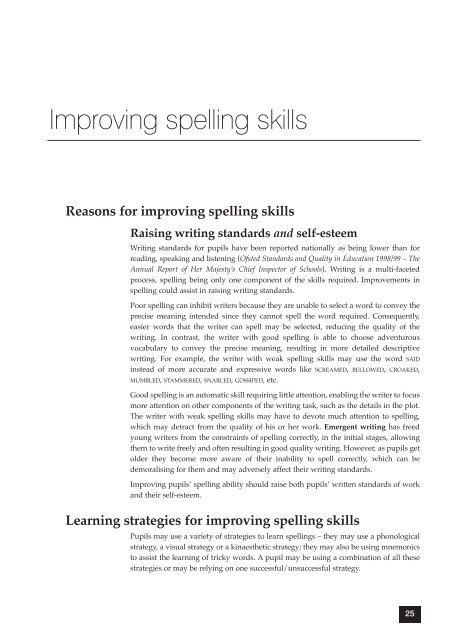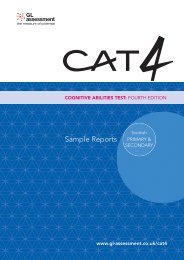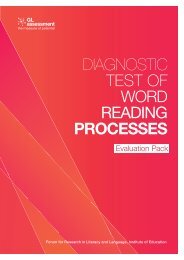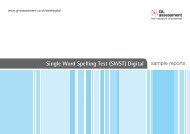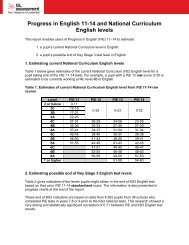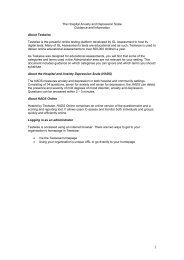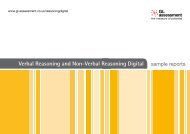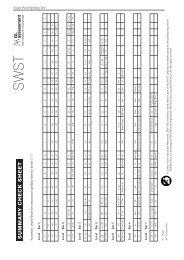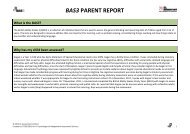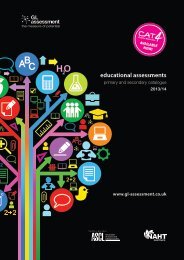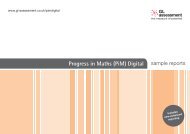Improving spelling skills
Improving spelling skills - GL Assessment
Improving spelling skills - GL Assessment
Create successful ePaper yourself
Turn your PDF publications into a flip-book with our unique Google optimized e-Paper software.
SWST_Manual:SWST Manual 2004 5/7/11 12:49 Page 25<br />
<strong>Improving</strong> <strong>spelling</strong> <strong>skills</strong><br />
Reasons for improving <strong>spelling</strong> <strong>skills</strong><br />
Raising writing standards and self-esteem<br />
Writing standards for pupils have been reported nationally as being lower than for<br />
reading, speaking and listening (Ofsted Standards and Quality in Education 1998/99 – The<br />
Annual Report of Her Majesty’s Chief Inspector of Schools). Writing is a multi-faceted<br />
process, <strong>spelling</strong> being only one component of the <strong>skills</strong> required. Improvements in<br />
<strong>spelling</strong> could assist in raising writing standards.<br />
Poor <strong>spelling</strong> can inhibit writers because they are unable to select a word to convey the<br />
precise meaning intended since they cannot spell the word required. Consequently,<br />
easier words that the writer can spell may be selected, reducing the quality of the<br />
writing. In contrast, the writer with good <strong>spelling</strong> is able to choose adventurous<br />
vocabulary to convey the precise meaning, resulting in more detailed descriptive<br />
writing. For example, the writer with weak <strong>spelling</strong> <strong>skills</strong> may use the word SAID<br />
instead of more accurate and expressive words like SCREAMED, BELLOWED, CROAKED,<br />
MUMBLED, STAMMERED, SNARLED, GOSSIPED, etc.<br />
Good <strong>spelling</strong> is an automatic skill requiring little attention, enabling the writer to focus<br />
more attention on other components of the writing task, such as the details in the plot.<br />
The writer with weak <strong>spelling</strong> <strong>skills</strong> may have to devote much attention to <strong>spelling</strong>,<br />
which may detract from the quality of his or her work. Emergent writing has freed<br />
young writers from the constraints of <strong>spelling</strong> correctly, in the initial stages, allowing<br />
them to write freely and often resulting in good quality writing. However, as pupils get<br />
older they become more aware of their inability to spell correctly, which can be<br />
demoralising for them and may adversely affect their writing standards.<br />
<strong>Improving</strong> pupils’ <strong>spelling</strong> ability should raise both pupils’ written standards of work<br />
and their self-esteem.<br />
Learning strategies for improving <strong>spelling</strong> <strong>skills</strong><br />
Pupils may use a variety of strategies to learn <strong>spelling</strong>s – they may use a phonological<br />
strategy, a visual strategy or a kinaesthetic strategy; they may also be using mnemonics<br />
to assist the learning of tricky words. A pupil may be using a combination of all these<br />
strategies or may be relying on one successful/unsuccessful strategy.<br />
25
SWST_Manual:SWST Manual 2004 5/7/11 12:49 Page 26<br />
Single Word Spelling Test<br />
Phonological strategy<br />
A phonological strategy involves applying phoneme-grapheme correspondence rules<br />
and higher order rules. These arbitrary rules for assigning letters and letter sequences<br />
to sounds differ across languages and need to be largely taught.<br />
Visual strategy<br />
A visual strategy involves memorising the written word as a pictorial letter sequence.<br />
This implies that whole words are stored in memory and can be retrieved when the<br />
word is required. A visual strategy is a natural strategy for most pupils that can be<br />
enhanced by practising memorising words as pictures of sequences of letters which<br />
convey a specific meaning.<br />
Kinaesthetic strategy<br />
A kinaesthetic strategy involves memorising the motor pattern involved in writing a<br />
word. This is a natural strategy that, for most pupils, can be enhanced through repeated<br />
practice of writing words.<br />
Teaching styles to improve <strong>spelling</strong> <strong>skills</strong><br />
Teaching <strong>spelling</strong><br />
When teaching <strong>spelling</strong> both the pupil’s natural and learnt strategies need to be<br />
considered. Teaching styles need to enhance the natural strategies and develop the<br />
learnt strategies that pupils use to learn <strong>spelling</strong>s. A phonological strategy can be totally<br />
taught and will be successful for 80% of English <strong>spelling</strong>s (Venezky, 1970).<br />
Visual strategies may be enhanced through looking for words within words and similar<br />
visual letter patterns such as ONE, DONE, GONE and BONE.<br />
Kinaesthetic strategies may be enhanced through practising writing words in cursive<br />
handwriting.<br />
Mnemonics can be learnt to deal with tricky words, as illustrated below.<br />
e.g. ➤ Using the initial letter of each word:<br />
– NECESSARY – Never Eat Cake Eat Salmon Sandwiches<br />
And Remain Young;<br />
– BECAUSE – Big Elephants Can’t Add Up Sums Easily.<br />
➤ Finding a fun element or a word within a word: SEPARATE – there’s A RAT<br />
in SEPARATE.<br />
➤ Making up a rhyme: DIFFICULTY<br />
Mrs D Mrs I Mrs FFI<br />
Mrs C Mrs U Mrs LTY.<br />
Different pupils use different strategies to learn <strong>spelling</strong>s. Some pupils use visual<br />
strategies to successfully learn words, negating the need to learn explicit rules. Some<br />
pupils appear to abstract the rules when learning lists of words with similar letter<br />
patterns, again overcoming the need to learn explicit rules. However, the explicit<br />
learning of rules makes the task of learning to spell English words easier for many<br />
pupils, and for some pupils it is the only way that they can learn <strong>spelling</strong>s.<br />
Consequently, the authors suggest that pupils should be explicitly taught the rules<br />
governing <strong>spelling</strong> so that those who need this input obtain it, while those who rely on<br />
other strategies can still do so.<br />
26
SWST_Manual:SWST Manual 2004 5/7/11 12:49 Page 27<br />
<strong>Improving</strong> <strong>spelling</strong> <strong>skills</strong><br />
A multi-sensory approach should be adopted when teaching <strong>spelling</strong> in order to fit in<br />
with both the natural and learnt strategies that pupils employ in the learning of<br />
<strong>spelling</strong>. Pupils should be encouraged to:<br />
➤<br />
➤<br />
➤<br />
➤<br />
➤<br />
➤<br />
look at sets of words;<br />
say those words;<br />
investigate the sets of words to discover patterns and rules;<br />
write the words;<br />
use the words in sentences to associate them with their meanings;<br />
memorise the words through covering each one, writing it and checking to<br />
see if it is correct. If it is not correct, repeat the procedure of covering,<br />
writing and checking again until it is correct. This is referred to as the<br />
‘look, say, cover, write, check’ method for learning <strong>spelling</strong>s (adapted from<br />
Peters & Cripps, 1978).<br />
Since the phonological strategy can be effectively taught, this is the strategy that will be<br />
predominantly focused on here. (Some reference will also be made to enhancing visual<br />
and kinaesthetic strategies and to mnemonics.)<br />
Addressing the errors made on the <strong>spelling</strong> test<br />
The rules for <strong>spelling</strong> vary in complexity and this is reflected in the seven levels of the<br />
structured <strong>spelling</strong> lists where words obeying the easier phoneme-grapheme rules are<br />
presented in the early levels and words obeying higher order complex rules are<br />
presented in the later levels. The rules can be considered in hierarchical terms.<br />
It is suggested that errors reflecting mastery of the lower levels of <strong>spelling</strong> knowledge<br />
be addressed before those reflecting higher levels. Consequently, errors should be<br />
addressed in the order:<br />
NP<br />
PS<br />
Non-phonetic (NP) errors<br />
PC<br />
NP errors indicate that a pupil does not know the simple phoneme-grapheme<br />
conversion rules, so these need to be taught first. The teacher needs to ensure that the<br />
pupil knows the sound-letter correspondences and can apply them when encoding<br />
CVC, CCVC, CVCC and CCVCC words.<br />
Phonetically simple (PS) errors<br />
PS errors indicate that the pupil is insecure with some of the rules that affect the sounds<br />
of letters, for example, MAC is a PS error for the word MAKE. The letters do correspond<br />
to the sounds but there is no knowledge about the final E affecting the vowel sound and<br />
that long vowel words ending in /k/ take K not C.<br />
Pupils need to learn the PS rules which enable them to distinguish and encode CVC,<br />
CCVC, CVCC, CCVCC, CVCV correctly, plus the vowel digraphs and simple prefixing<br />
and suffixing rules presented in Levels 2, 3 and 4 of the structured <strong>spelling</strong> lists.<br />
27
SWST_Manual:SWST Manual 2004 5/7/11 12:49 Page 28<br />
Single Word Spelling Test<br />
Phonetically complex (PC) errors<br />
PC errors indicate that the pupil does not know some of the rules governing the<br />
inclusion of specific letters and the positional constraints of letters in words. These rules<br />
should be taught from the easier rule-governed words involving suffixes in Levels 1 and<br />
2, to the more complex rule-governed words in Levels 5, 6 and 7.<br />
An approach to whole class teaching of <strong>spelling</strong><br />
In a whole class the pupils are unlikely to all be at the same level of attainment in<br />
<strong>spelling</strong>. While the pupils could have individual <strong>spelling</strong>s matched to their specific<br />
need, the management of this could be very daunting for teachers. Consequently, the<br />
following suggestion is thought to be a manageable option for teaching <strong>spelling</strong> to a<br />
whole class.<br />
The level on the structured <strong>spelling</strong> lists should be found for each pupil, through<br />
analysing and sorting the errors made on the SWST. Three groups should be made by<br />
selecting a low level, medium level and high level appropriate for the class. For<br />
example, in a class of 30 Year 4 pupils, there might be two pupils on Level 1, four pupils<br />
on Level 2, four pupils on Level 3, ten pupils on Level 4, eight pupils on Level 5 and two<br />
pupils on Level 6.<br />
Then the three main groups chosen for this class might be:<br />
➤ the low group – Level 2/3<br />
➤ the middle group – Level 4<br />
➤ the high group – Level 5/6.<br />
The two pupils working on Level 1 would need to continue on this level, thus forming<br />
a fourth group; however, these pupils could be individually helped by a special needs<br />
teacher or teaching assistant, enabling the teacher to focus on the three main <strong>spelling</strong><br />
groups. The low group contains pupils needing to work at Level 2; one way to deal with<br />
this is for the whole of the low group to learn the words from Level 2 that these pupils<br />
need to learn, and progress to Level 3 rapidly. Alternatively, work at Level 3 but give<br />
the four children at Level 2 extra <strong>spelling</strong>s from Level 2.<br />
This method of assigning pupils to the best-fit groups based on their level of attainment<br />
in <strong>spelling</strong> necessarily involves some pupils in re-learning lists, but this should not be<br />
regarded as wasting the pupils’ time. On the contrary, it can be regarded as<br />
consolidating recently acquired knowledge provided that the re-learning is from an<br />
adjacent level, not two or three levels below the pupil’s working level.<br />
Suggestions for teaching <strong>spelling</strong>s to primary<br />
school pupils<br />
The three groups could be presented with a new <strong>spelling</strong> target each week. Each group<br />
could be given a list of <strong>spelling</strong>s from the appropriate level of the structured <strong>spelling</strong><br />
lists. These words could be looked at and discussed as a whole class to focus attention<br />
on the similarity of the words. The rules can be made explicit through using verbal<br />
questions and answers and guided learning techniques.<br />
28
SWST_Manual:SWST Manual 2004 5/7/11 12:49 Page 29<br />
<strong>Improving</strong> <strong>spelling</strong> <strong>skills</strong><br />
e.g. Given this set of words for one group, HOPE CLOSE HOME CHOSE BROKE SLOPE,<br />
useful questions could be:<br />
➤ What do you notice about all of these words?<br />
➤ What sound does the O make?<br />
➤ What sounds can the letter O make in words?<br />
➤ Why do these letter Os make the long vowel sound?<br />
➤ Can you make a rule to explain the <strong>spelling</strong>s of these words?<br />
The word level in the Literacy Hour requires this type of exploration and investigation<br />
of word families with the whole class. All three groups of words could be verbally<br />
discussed by the class. The pupils could then focus on the set of words assigned to them.<br />
They could use the ‘look, say, cover, write, check’ method for writing the words in a<br />
<strong>spelling</strong> book which the pupils can be encouraged to take home and learn.<br />
The pupils should be given the opportunity to use the words, either by writing<br />
sentences or engaging in activities using a dictionary or thesaurus, to assist with<br />
associating the meanings with the words. During the week the pupils could be given<br />
further practice to assist in learning their <strong>spelling</strong>s, perhaps linking it with handwriting.<br />
At the end of the week the pupils should be tested on their weekly <strong>spelling</strong>s. The pupils<br />
should be rewarded if they get their <strong>spelling</strong>s correct. Errors on this test could be rewritten<br />
using the learning procedure ‘look, say, cover, write, check’. If appropriate, the<br />
teacher may want to re-test the pupils after another learning period.<br />
At the end of a half-term/whole term, the pupils could be informally tested to see if the<br />
letter patterns focused on have actually been learnt, that is retained correctly after a<br />
period of time.<br />
Consideration must be given to those pupils who frequently write incorrect <strong>spelling</strong>s<br />
each week, or do badly on the informal assessment. Reasons for the poor results should<br />
be sought. If a pupil has tried to learn his or her words at home with help from his or<br />
her family and has had time to practise at school, then it may be assumed that the words<br />
are too hard and an easier set of words should be given. Some pupils need to repeat the<br />
same lists several times and the suffixing sections permit this re-visiting of word lists.<br />
Pupils who repeatedly learn <strong>spelling</strong>s and appear to be unable to retain them may<br />
require more detailed diagnostic help. Further advice should be sought, initially from<br />
the special needs teacher.<br />
Suggestions for teaching <strong>spelling</strong>s to secondary<br />
school pupils<br />
Secondary pupils may be able to take more responsibility for their own learning of<br />
<strong>spelling</strong>. The <strong>spelling</strong> test for each pupil should be analysed and the errors recorded as<br />
previously described. Each pupil’s level on the structured <strong>spelling</strong> lists, and the<br />
components of words not known, should be ascertained from the results of their SWST.<br />
The pupils should be encouraged to work individually on the sections containing the<br />
components where they made errors, from the easiest level up to the highest level. The<br />
pupils can be encouraged to use the structured <strong>spelling</strong> lists themselves to focus on a<br />
section of words, to look for patterns and to try to write a rule for the words. A<br />
discussion of the rules generated and the explanation of the correct rule can be given in<br />
the plenary session. The pupils could be encouraged to learn their <strong>spelling</strong>s using the<br />
‘look, say, cover, write, check’ method.<br />
29


